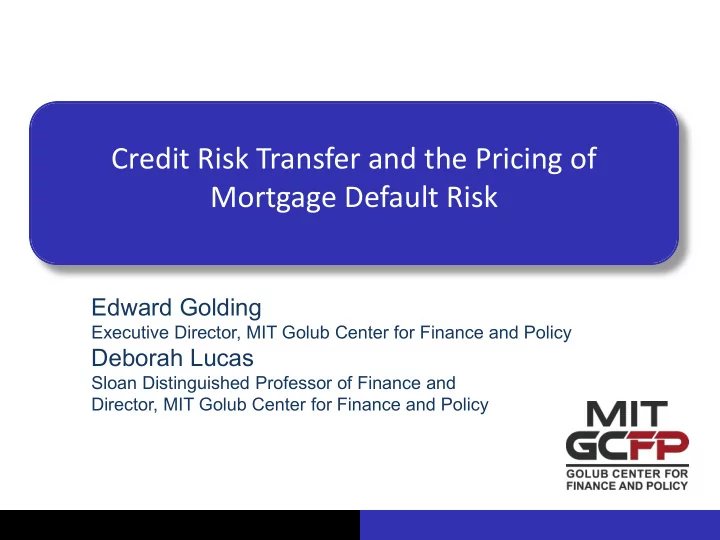

Credit Risk Transfer and the Pricing of Mortgage Default Risk Edward Golding Executive Director, MIT Golub Center for Finance and Policy Deborah Lucas Sloan Distinguished Professor of Finance and Director, MIT Golub Center for Finance and Policy
Introduction The Housing and Economic Recovery Act of 2008 required the GSEs to develop and implement mechanisms for credit risk transfer (CRT) The main way the GSEs comply with that mandate is with CRT securities This analysis addresses the question of whether CRT securities are an effective and efficient means of credit risk transfer? Our (still preliminary) findings suggest that: CRT securities provide opaque price signals that may provide little marginal information about mortgage market risk CRT securities may be a relatively expensive way for the GSEs to transfer risk to private sector investors Part of a broader research agenda that investigates the costs and risks of government investment and financing decisions 2
Potential benefits of CRT for GSEs Information revelation Creates market-price signals about cost of risk in conforming mortgage market That information is otherwise unavailable while the GSEs are in conservatorship Transfers risk from government/taxpayers to private sector Risk transfer in itself is unlikely to add value while GSEs in conservatorship • Private investors must be paid to take on the risk (zero NPV at best) • Requires private sector to be more efficient at allocating the risk to have value-added If GSEs are (re)privatized then CRT can reduce their systemic risk • Similar to benefits for other TBTF institutions • Potentially a partial substitute for capital requirements, but is it a desirable substitute? 3
Potential drawbacks of CRT securities (issuer/gov’t perspective) Opaque and illiquid Highly complex structures, hard to price Limited investor base, limited competition Hard to infer information about overall mortgage market cost of risk Significant issuance costs Amount of risk transfer is difficult to assess, and it varies over time Depends on structural details that differ across issuances GSEs may refrain from issuing them when price of risk is elevated, when the price information would be most valuable Market participants love them 4
What are CRT securities? Can be thought of as highly structured catastrophe bonds or credit default swaps, where buyers earn a high coupon, but their principal is reduced as defaults on a reference pool of mortgages are realized. 5
Trends in default cost “Default cost” is principal-weighted average of CRT coupons at issuance Expressed as a ratio to the reference pool of mortgages, in basis points Suggestive but not a true cost measure Default cost averages about 17 bps (when fair A -H spread is 0, blue dots) Cost estimates are sensitive to unobserved value of fully retained tranches Default cost jumped post-pandemic, but still in line with historical costs GSEs stopped issuing for several months during height of market disruptions 6
Sharp price drops in secondary market post-Covid Data source: Vista Security Services Information obtained from secondary market is also indicative of high issuance costs and illiquidity 7
What correlates with default cost? Default cost is highly correlated with the BB spread (correlation = .72) Also positively correlated with 120-day mortgage delinquency rate but less so delinquencies are only marginally significant in a regression on BB spread and delinquencies Raises question of whether CRT pricing more indicative of housing market or of high yield market? 8
Is default cost information used to set g-fees? Clearly not. (Correlation = .15) 9
Trends in retained share by GSEs “Retained share” is the portion of the default cost held by the GSEs in retained tranches Estimate is also quite sensitive to unobservable value of fully retained tranches We calculate average retention of about 50%, much higher than GSE -reported retention of less than 25% Fairly stable over time, did not increase after the onset of the pandemic 10
Example: expected returns on STACR 2019-DNA1 tranches Table 5: Summary statistics for realized returns by tranche, annualized rates, base case M1 M2 B1 B2 mean 0.0342 0.0528 0.0735 0.0570 std dev 0.0002 0.0000 0.0027 0.0503 max 0.0346 0.0528 0.0740 0.1257 min 0.0341 0.0528 0.0445 -0.2282 median 0.0341 0.0528 0.0740 0.0685 count 500 500 500 500 The mezzanine tranches have almost no exposure to default risk, yet their expected return is one or two percentage points higher than LIBOR The B1 tranche is riskier than the M2 tranche, but it absorbs much less credit risk and has a higher expected return, than corporate bonds with comparable ratings Suggests CRT securities are rated conservatively relative to corporate bonds of similar risk Expected returns on the mezzanine tranches are fairly insensitive to significant increases in assumed default risk 11
Concluding remarks The analysis of STACR 2019-DNA1, and evidence on transactions costs and market liquidity, point to the conclusion that CRT securities are a relatively expensive way for the GSEs to transfer risk We plan to conduct a similar analysis for a larger sample of CRT securitizations A modest structural change that could reduce the GSEs’ cost with minimal reduction in the amount of risk transferred would be for the GSEs to retain a larger share of the mezzanine tranches 12
Recommend
More recommend